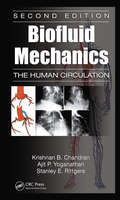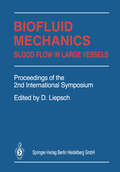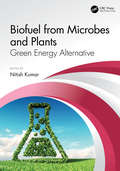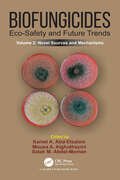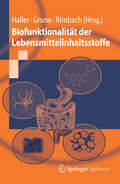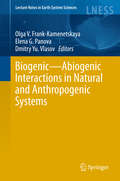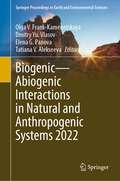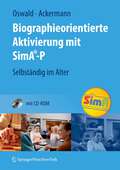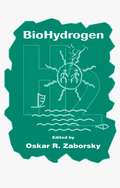- Table View
- List View
Biofluid Mechanics: The Human Circulation, Second Edition
by Krishnan B. Chandran Stanley E. Rittgers Ajit P. YoganathanDesigned for senior undergraduate or first-year graduate students in biomedical engineering, Biofluid Mechanics: The Human Circulation, Second Edition teaches students how fluid mechanics is applied to the study of the human circulatory system. Reflecting changes in the field since the publication of its predecessor, this second edition has been ex
Biofluid Mechanics: Blood Flow in Large Vessels
by Dieter W. LiepschProceedings of the 2nd International Symposium Biofluid Mechanics and Biorheology. June 25-28, 1989, Munich
Biofluid Mechanics · 2
by D. J. SchneckThe Department of Engineering Science and Hechanics at Virginia Polytechnic Institute and State University spon sored the First Mid-Atlantic Conference on Bio-Fluid Mechanics, which was held in Blacksburg, Virginia during the period 9-11 August 1978. Some 40 life-scientists, engineers, physicians and others who share a common interest in the advancement of basic and applied knowledge in bio fluid mechanics gathered at the Donaldson Brown Center for Continuing Education to hear 25 papers presented in seven technical sessions. At the conclusion of the conference, those present decided unanimously that its success warranted having at least one more -- and that it was conceptually a sound idea to plan it on a biennial basis for late spring. Hence, the second Mid-Atlantic Conference on Bio Fluid Mechanics took place at Virginia Tech on May 4-6, 1980. This volume documents the Proceedings of the second conference. It contains full texts of 23 contributed papers, 2 guest lectures and 1 invited seminar. The papers are gr9uped according to subject matter, beginning with 3 in the area of respiration, followed by 1 in kidney dialysis, 1 in reproduction, 1 in joint lubrication, 1 in prosthetic fluidics, 2 in zoology, and ending with 14 in the general field of cardiovascular dynamics. Of the latter, 5 deal with the subject of heart valves, 2 concern themselves with the microcirculation, 6 address vascular system hemodynamics and 1 covers some aspects of blood rheology.
Biofluidmechanik: Grundlagen und Anwendungen
by Dieter LiepschDieses Buch führt Sie in die Grundlagen der Biofluidmechanik einWie funktioniert der menschliche Blutkreislauf? Wie arbeiten Mikrozirkulationsvorgänge? Mit diesen und vielen weiteren Fragen der Strömungsuntersuchung beschäftigt sich die Biofluidmechanik. Dieses Buch gewährt ihnen interessante Einblicke in die Grundlagen der Biofluidmechanik.Die Biofluidmechanik ist eine thematisch sehr breit gestaffelte Wissenschaft. Sie erforscht die Gesetzmäßigkeiten der Bewegung, des Kräftegleichgewichtes und der Strömungstechnik von Fluiden. Hierzu gehören unter anderem:• Atmung• Blutkreislauf• Mikrozirkulationsvorgänge• Lymphströmungen• Künstliche Gefäßersatze• Gefäßprothesen aus verschiedenen Materialien• Künstliche Herzklappen• Urologische Messungen• Künstliche Harnleiter• Blutrheologie• Transport durch Membranen• Bewegung geladener Partikel• Ionen in Lösungen• Vibrationen• Wellenfortpflanzung und SchockwellenWichtiges Grundlagenwissen der Biofluidmechanik in einem Buch In seinem Buch gibt der Autor einen ausführlichen Überblick über die Grundlagen der Biofluidmechanik und stellt die folgenden Themen detailliert vor:• Einleitung in die Biofluidmechanik• Physikalische Grundlagen von Fluiden• Rheologische Grundlagen• Biofluide (Körperflüssigkeiten) in Menschen und Tieren• Grundlegende theoretische Fluid- bzw. hämodynamische Betrachtungen• Medizinische Grundlagen, menschliches Kreislaufsystem, Blutgefäße, Herz, Lungenmechanik und Atmung• Besonderheiten und Messmethoden der Biofluidmechanik• Anwendungen und Beispiele in Modellen, diagnostische und therapeutische BedeutungAufgrund des hohen Praxisbezugs ist dieses Buch über die Biofluidmechanik nicht nur für Studenten, sondern auch für Beschäftigte in Gesundheitsforschung und Medizin ein wichtiges und hilfreiches Grundlagenwerk.
Biofluids Modeling: Methods, Perspectives, and Solutions
by Wilson C. Chin Jamie A. ChinBIOFLUIDS MODELING The first book offering analytical and modern computational solutions to important biofluids problems, such as non-Newtonian flows in blood vessels, clogged arteries and veins, bifurcated arteries and veins, arbitrary stent geometries, tissue properties prediction, and porous media Darcy flow simulation in large-scale organ analysis, this is a must-have for any library. This book introduces new methods for biofluids modeling and biological engineering. The foregoing subjects are treated rigorously, with all modeling assumptions stated and solutions clearly derived. But that’s not all. Key supporting physics-based ideas, algorithmic details, and software design interfaces are equally emphasized, in order to support our overriding objective of getting the anatomical and clinical information that physicians need. Importantly, this volume provides a self-contained exposition that includes all required biological concepts, plus the background preparation needed in fluid mechanics, basic differential equations, and modern numerical analysis. The presentation style will appeal to medical practitioners, researchers, biomedical engineers, and students interested in quantitative fluid flow modeling, as well as engineering students eager to learn about advances in a rapidly growing and changing biological science. As such, the book represents “must-reading” suitable at the advanced undergraduate level, and motivated readers should be able to embark on related research following guided study.
Biofluids Modeling: Methods, Perspectives, and Solutions
by Wilson Chin Jamie ChinBIOFLUIDS MODELING The first book offering analytical and modern computational solutions to important biofluids problems, such as non-Newtonian flows in blood vessels, clogged arteries and veins, bifurcated arteries and veins, arbitrary stent geometries, tissue properties prediction, and porous media Darcy flow simulation in large-scale organ analysis, this is a must-have for any library. This book introduces new methods for biofluids modeling and biological engineering. The foregoing subjects are treated rigorously, with all modeling assumptions stated and solutions clearly derived. But that’s not all. Key supporting physics-based ideas, algorithmic details, and software design interfaces are equally emphasized, in order to support our overriding objective of getting the anatomical and clinical information that physicians need. Importantly, this volume provides a self-contained exposition that includes all required biological concepts, plus the background preparation needed in fluid mechanics, basic differential equations, and modern numerical analysis. The presentation style will appeal to medical practitioners, researchers, biomedical engineers, and students interested in quantitative fluid flow modeling, as well as engineering students eager to learn about advances in a rapidly growing and changing biological science. As such, the book represents “must-reading” suitable at the advanced undergraduate level, and motivated readers should be able to embark on related research following guided study.
Biofortification of Food Crops
by Ummed Singh C S Praharaj S S Singh N P SinghThe chapters presented in this book ‘Biofortification of Food Crops’ depict how agricultural technological interventions have true role in alleviating malnutrition. This book highlights the role of multidisciplinary approaches to cope up with the challenges of micronutrient malnutrition or hidden hunger which is an alarming public health issue in most parts of the world including India. In this endeavour, different biofortification approaches such as agronomic (or ferti-fortification), breeding, biotechnological, physiological, microbial etc. has fulfilled their different mandates of nutrient enrichment of food crops including cereals and pulses. The contents of the book proves that biofortified plants have adequate potential to nourish nutrient depleted soils, help increase crop productivity and provide nutritional benefits to plants, humans and livestock. The content and quality of information presented in this book will definitely provide multiple novel ideas of advance techniques and will stimulate innovative thoughts and directions amongst researchers and policy makers in the field of biofortification. In addition, the contributions presented in the book will be a good source of background knowledge and technical know-how to educate the readers about biofortification. The authors hope that the book entitled “Biofortification of Food Crops” would provide a suitable platform in our collective efforts for an appropriate dialogue among the scientists, researchers, entrepreneurs, policy makers and farmers in reducing the budding issues of malnutrition through novel approaches and means.
Biofuel from Microbes and Plants: Green Energy Alternative
by Nitish KumarGlobal concern for energy security and environmental protection has put great emphasis on the search for alternative energy sources, particularly for the transport sector. Biofuels have emerged as a highly promising source of alternative energy, and have drawn global research and development for their production using biomass. With the increasing worldwide demand for energy, along with the depletion of conventional fossil fuel reserves, there has been growing global interest in developing alternative sources of energy. There has also been concern in growing economies regarding energy security. Biofuels offer much promise on these frontiers. In addition to these factors, they also have a reduced environmental impact in comparison to fossil fuels. Biofuels from Microbes and Plants provides state-of-the-art information on the status of biofuel production and related aspects. Academics, researchers, engineers, and technologists will develop a greater understanding of the relevant concepts and solutions to the global issues related to achieving alternative energy applications for future energy security, as well as environmental sustainability in medium- and large-scale industries. Key Features Detailed overview of the alternative energy field and the role of biofuels as new energy sources Detailed accounts of the production of biodiesel from non-conventional bio-feedstocks such as algae, microbes, and vegetable oils Recent updates about biotechnological improvements of plant and microbial sources for biofuel production
Biofuel from Microbes and Plants: Green Energy Alternative
by Nitish KumarGlobal concern for energy security and environmental protection has put great emphasis on the search for alternative energy sources, particularly for the transport sector. Biofuels have emerged as a highly promising source of alternative energy, and have drawn global research and development for their production using biomass. With the increasing worldwide demand for energy, along with the depletion of conventional fossil fuel reserves, there has been growing global interest in developing alternative sources of energy. There has also been concern in growing economies regarding energy security. Biofuels offer much promise on these frontiers. In addition to these factors, they also have a reduced environmental impact in comparison to fossil fuels. Biofuels from Microbes and Plants provides state-of-the-art information on the status of biofuel production and related aspects. Academics, researchers, engineers, and technologists will develop a greater understanding of the relevant concepts and solutions to the global issues related to achieving alternative energy applications for future energy security, as well as environmental sustainability in medium- and large-scale industries. Key Features Detailed overview of the alternative energy field and the role of biofuels as new energy sources Detailed accounts of the production of biodiesel from non-conventional bio-feedstocks such as algae, microbes, and vegetable oils Recent updates about biotechnological improvements of plant and microbial sources for biofuel production
Biofunctional Surface Engineering
by Martin ScholzSuccessful biofunctional surface engineering will determine the future of medical devices such as orthopedic implants, stents, catheters, vaccine scaffolds, wound dressings, and extracorporeal circulation devices. Moreover, the biosensor and diagnostic chip technology will evolve rapidly due to the growing medical need for personalized medicine. A
Biofungicides: Novel Sources and Mechanisms, Volume 2
by Kamel A. Abd-Elsalam Mousa A. Alghuthaymi Salah M. Abdel-MomenThe current volume focuses on novel sources of biofungicides, primarily providing complete knowledge of microbial and phytochemical fungicides, studying antifungal activity mechanisms as well as their role in disease management in plants, and fungicide bioremediation. The use of biofungicides as eco-friendly alternative to typical synthetic fungicides is projected to play a significant role in organic farming in the future.Key Features: Discovers novel sources of biofungicides Describes the role of biofungicides in the control of plant diseases Studies antifungal activity mechanisms Explores how to survey and select promising biofungicides
Biofungicides: Novel Sources and Mechanisms, Volume 2
The current volume focuses on novel sources of biofungicides, primarily providing complete knowledge of microbial and phytochemical fungicides, studying antifungal activity mechanisms as well as their role in disease management in plants, and fungicide bioremediation. The use of biofungicides as eco-friendly alternative to typical synthetic fungicides is projected to play a significant role in organic farming in the future.Key Features: Discovers novel sources of biofungicides Describes the role of biofungicides in the control of plant diseases Studies antifungal activity mechanisms Explores how to survey and select promising biofungicides
Biofunktionalität der Lebensmittelinhaltsstoffe (Springer-Lehrbuch)
by Dirk Haller, Gerald Rimbach and Tilman GruneFunktionelle Lebensmittel wirken nachweisbar stärker positiv auf die menschliche Gesundheit als normale. Das erste Lehrbuch zum Thema behandelt systematisch die Organfunktionen des Körpers und zeigt die Methoden, mit denen eine präventive Wirkung nachgewiesen werden kann. „Steckbriefe“ aller relevanten Klassen von Lebensmittelinhaltsstoffen und deren Wirksamkeit bieten einen guten Überblick. Ergänzt wird das mit Abbildungen und Themenboxen anschaulich gestaltete Nachschlagewerk für Studenten und Lebensmittelexperten durch zahlreiche Fallbeispiele.
Biogene Arzneistoffe: Entwicklungen auf dem Gebiet der Pharmazeutischen Biologie, Phytochemie und Phytotherapie
by Franz-C. CzyganBiogenesis Evolution Homeostasis: A Symposium by Correspondence
by Alfred LockerIn 1963, 1965 and 1967 "Symposia on Quantitative Biology of Metabolism" were organized on the pretty island of Helgoland (Biologische Anstalt) by me in col laboration with O. KINNE and F. KROGER. Unfortunately this worthy approach towards bringing together interested scholars in a regular way ceased, mainly for financial reasons, although the need for and interest in conferences like these for the exchange of ideas on special topics unchangeably persists. So I had to look for other possibilities and one of them was to try to arrange a similar con ference under the auspices of NASA. This institution, however, eventually re-. treated, although during my discussion with its representatives a new special theme gained shape. This is the topic to which this volume is devoted: Bio genesis. It is also treated in a new way that probably could be a model for. similar undertakings: a symposium by correspondence. In this new approach to scientific information exchange, manuscripts were collected by the editor and sent to every contributor for his comments. The author could then reply by means of a concluding remark. So, in many instances very valuable ideas concerning the topics of the several papers could be gathered and it is to be hoped that this procedure has conferred upon this volume a certain uniqueness. Of course, I had to observe the agreement with Springer-Verlag not to exceed the extent of the volume allotted to us.
The Biogenesis of Cellular Organelles (Molecular Biology Intelligence Unit)
by Chris MullinsThe Biogenesis of Cellular Organelles represents a comprehensive summary of recent advances in the study of the biogenesis and functional dynamics of the major organelles operating in the eukaryotic cell. This book begins by placing the study of organelle biogenesis in a historical perspective by describing past scientific strategies, theories, and findings and relating these foundations to current investigations. Reviews of protein and lipid mediators important for organelle biogenesis are then presented, and are followed by summaries focused on the endoplasmic reticulum, Golgi, lysosome, nucleus, mitochondria, and peroxisome.
Biogenic—Abiogenic Interactions in Natural and Anthropogenic Systems: Abiogenic Interactions In Natural And Anthropogenic Systems (Lecture Notes in Earth System Sciences)
by Olga V. Frank-Kamenetskaya Elena G. Panova Dmitry Yu. VlasovThis book offers a collection of papers presented at the V International Symposium "Biogenic - abiogenic interactions in natural and anthropogenic systems" that was held from 20-22 October 2014 in Saint Petersburg (Russia). Papers in this book cover a wide range of topics connected with interactions between biogenic and abiogenic components in the lithosphere, biosphere and technosphere. The main topics include: biomineralization in geosystems, geochemistry of biogenic-abiogenic systems, biomineral interactions in soil, minerals in living organisms and biomimetic materials, medical geology, bioweathering and destruction of cultural heritage.
Biogenic—Abiogenic Interactions in Natural and Anthropogenic Systems 2022 (Springer Proceedings in Earth and Environmental Sciences)
by Olga V. Frank-Kamenetskaya Dmitry Yu. Vlasov Elena G. Panova Tatiana V. AlekseevaThe book represents a collection of papers presented at VII International Symposium "Biogenic-abiogenic interactions in natural and anthropogenic systems" that was held on 26-29 September 2022 in Saint Petersburg (Russia). Papers in this book cover a wide range of topics connecting with interactions between biogenic and abiogenic components in lithosphere, biosphere and technosphere. The main regarding topics are following: biomineralization in living organisms and nature-like materials; biomineralization in geosystems; geochemistry of biogenic-abiogenic systems; biomineral interactions in soil; interaction of microorganisms with natural and artificial materials; medical geology; philosophical aspects of interdisciplinary researchs
Biogeogens and Human Health (SpringerBriefs in Public Health)
by Niraj KumarHealth of the people is the most important indicator of the development of a nation. Health is a state of complete physical, mental and social well being and not merely the absence of disease or infirmity (as defined by WHO). The state of health of an individual or population depends upon complex interaction of the physical, biological, political and social domains. The environment affects the human health in a big way. People tend to be most susceptible to illness when physically or mentally stressed. Stress, energy and immunity form a closely knit network. Through his experimental findings, the author has brought out this intricate concept of interdependence of biotic (living) and abiotic (non-living) factors in an ecosystem, resulting in an impact on human health, in an explicitly marvelous manner. As a result, a new word “Biogeogens” has been coined, “bio” for living (biotic) , “geo” for non-living (abiotic/geographical/climatic/environment) and “gens” for the interactive proceeds of the two. The content included herein is directly concerned with the societal health and gives a clue to many socio-psycho health problems presently not handled with care. It also defines a multidimensional approach for dealing with many psychosomatic and health problems.
Biografiearbeit: in der Gesundheits-, Kranken- und Altenpflege
by Monika Specht-TomannBiografiearbeit als ein Instrument in der Kranken- und Altenpflege schärft den Blick für die Bedürfnisse von Patienten. Auf diese Art und Weise werden die Ressourcen von Patienten für deren Gesundung genutzt, alte Menschen werden aktiviert und damit ihre Lebensqualität verbessert. In dem Band erläutert die Autorin verschiedene Methoden der Biografiearbeit und bietet Schritt-für-Schritt-Anleitungen für deren Umsetzung. In der 2., überarbeiteten Auflage geht sie ausführlicher auf spezielle Patientengruppen wie u. a. demenzkranke Menschen ein.
Biografiearbeit: in der Gesundheits-, Kranken- und Altenpflege
by Monika Specht-TomannBiografiearbeit ist ein Instrument in der Kranken- und Altenpflege, mit dem der Blick für das Leben der Patienten bzw. der Bewohner geschärft und der ganzheitliche Zugang zu ihren Bedürfnissen erleichtert wird. Fähigkeiten von Alten und Kranken werden durch Biografiearbeit aktiviert und verbessert. Das Buch ist mit zahlreichen Anleitungen zur Umsetzung der verschiedenen Methoden und mit vielen Beispielen aus der Pflege- und Betreuungspraxis eine Unterstützung für alle, die mit alten und kranken Menschen arbeiten.
Biografiearbeit: in der Gesundheits-, Kranken- und Altenpflege
by Monika Specht-TomannBiografiearbeit als ein Instrument in der Kranken- und Altenpflege schärft den Blick für die Bedürfnisse von Patienten. Auf diese Art und Weise werden die Ressourcen von Patienten für deren Gesundung genutzt, alte Menschen werden aktiviert und damit ihre Lebensqualität verbessert. In dem Band erläutert die Autorin verschiedene Methoden der Biografiearbeit und bietet Schritt-für-Schritt-Anleitungen für deren Umsetzung. In der 2., überarbeiteten Auflage geht sie ausführlicher auf spezielle Patientengruppen wie u. a. demenzkranke Menschen ein.
Biographical History of Behavioral Neuroendocrinology
by Randy J. Nelson Zachary M. WeilBehavioral neuroendocrinologists are interested in the interactions between hormones and behaviors. This unique book tracks the development of behavioral neuroendocrinology from the first recognized paper in the field by Arnold Berthold in 1849 to the major contributors of the past century. It traces the history and development of the field by exploring the women and men who conducted the studies that revealed these hormone-behavioral relationships. Most chapters are written by the individuals who knew these pioneers best, and describe their stories and discuss the ways in which their work has shaped the field. Now is the perfect time for this book. The field is burgeoning and interest in the development of theoretical perspectives is thriving. Moreover, although this field was dominated by men early on, it has become a field with near sexual parity among its faculty, society membership, and leadership, and thus serves as an example of equitable science, training, and advocacy.
Biographieorientierte Aktivierung mit SimA-P: Selbständig im Alter
by Wolf-D. Oswald Andreas AckermannWenn alte Menschen über ihre Erinnerungen sprechen, kann das dem Verlust von Identität und Selbstwissen entgegenwirken. Der praxiserprobte Leitfaden zur biographieorientierten Aktivierung stellt neben einem kurzen allgemeinen Teil insgesamt 28 Therapieeinheiten vor. Ablaufpläne und Arbeitsmaterialien für die Gruppenarbeit erleichtern die Umsetzung. Die mitgelieferte CD-ROM enthält Kopiervorlagen. Der Band richtet sich an alle Personen, die beruflich oder ehrenamtlich im Bereich der Alltagshilfe tätig sind.
BioHydrogen
by Oskar R. ZaborskyThe world needs clean and renewable energy and hydrogen represents an almost ideal resource. Hydrogen is the simplest and most abundant molecule in the universe, yet one that is a challenge to produce from renewable resources. Biohydrogen, or hydrogen produced from renewable resources such as water or organic wastes by biological means, is a goal worthy of increased global attention and resources. The purpose of BioHydrogen '97 was to bring together leaders in the biological p- duction of hydrogen from the United States, Japan, Europe, and elsewhere to exchange scientific and technical information and catalyze further cooperative programs. Parti- pants came from at least different countries representing academia, industry, and g- ernment. Especially important participants were young research scientists and engineers: the next generation of contributors. The conference consisted of plenary presentations, topical sessions, posters, and mini-workshop discussions on key areas of biohydrogen. It was designed to maximize - formation exchange, personal interaction among participants, and formulate new inter- tional initiatives. BioHydrogen '97 was an outgrowth of an international workshop convened by the Research Institute of Innovative Technology for the Earth (RITE) and was held in Tokyo, Japan, November 24-25, 1994. The RITE workshop was highly successful but largely l- ited to traditional biochemical and biological studies and not engineering research topics.
